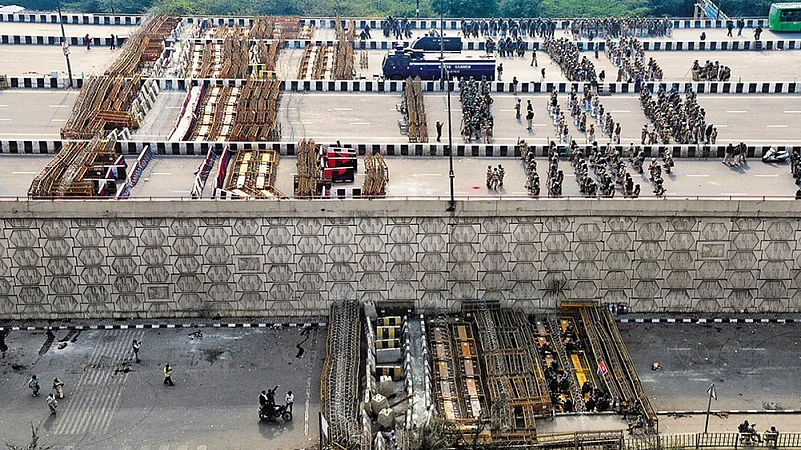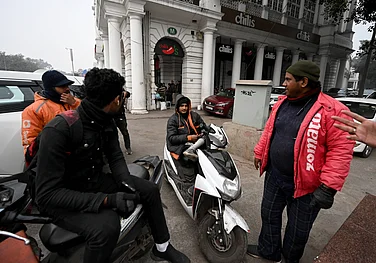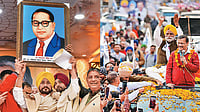It was a chilly night on January 30. I was there to report on a mob attack on farmers at the Singhu border, which had taken place the day before. Suddenly, I found myself being dragged to the lock-up by police. They were beating me with batons all along the way. Shortly after my arrest, a video of “police atrocity on a journalist” went viral on social media.
It was not the first time during the movement that journalists had to endure lathi blows, tear-gas shells and manhandling. Many journalists had to face such treatment from the men in khaki. There are many people who try to defend the aggression meted out by police on protestors during the movement, with loaded words like “law and order”. It is true that one of the central features of democracy is upholding of the rule of law. However, it often exists as a governing principle on official papers, while the ground reality is completely different.
With the same camera that was broken by police on the night of January 30, I had shot a video in which several Delhi Police officers were caught gesticulating to an anti-farmer mob that had thronged the Singhu border to hurl stones at the protesting farmers. Thankfully, that video is still safe with me. I also have similar footage from Hisar district, in which officers of Haryana Police can be seen pelting stones at farmers themselves. To me, Haryana Police appeared more “sorted”, because, instead of inviting a mob to throw stones, they thought it wise to do the job themselves.
On January 31, when I was sent to Tihar jail, I met many farmers there. They all showed me marks of lathi-blows on their bodies, and said, “Show us your injuries.” Jasminder Singh, 43, a farmer from Punjab’s Peron village, who was locked up with me in a small cell, looked at me with moist eyes, lifting his pyjamas to show injuries on his feet. “Look at how mercilessly police have assaulted us,” he said.
One by one, Jasminder showed me all the injury marks on his body. The big blue marks told their own tales. They were proof he had been beaten black and blue with canes by the cops.

In custody—In jail, Punia scribbled notes on his leg
Jasminder was seething with fury while showing those injuries. When his anger subsided, he broke his long silence, and said, “On January 29, many farmers had gone to get goods from Narela market. On our way back, police attacked us with lathis. We were all unarmed. After raining lathi blows on us, police forced around 30 of us into a green bus and brought us to a police station. After our medical examination, we were all sent to Tihar jail.”
ALSO READ: 'Hum Dekhenge': Times When India Protested
A researcher, Shailaja, who is working on a report on police behaviour with farmers in the course of the movement, told me that based on data she had gathered so far, Haryana Police had registered the highest number of cases against farmers among all states. Maximum number of arrests of farmers as well as police lathicharge on them has also taken place in Haryana. From the very beginning of this movement, not only were police putting people under surveillance in the name of law and order, but also keeping them under house arrest. They have illegally detained people and slapped false cases on them as well. Even in lock-up, farmers were treated shamefully.”
The pictures that went viral during the movement will be etched in our memories forever. The scariest was a video from August 28, in which Karnal SDM Ayush Singha could be heard asking policemen to smash the heads of farmers. That same day, many farmers sustained head injuries, and one of them died.
Police resorted to lathicharge six times that day, which cost the life of Sushil Kajal, a farmer from village Raipur Jatan in Karnal district. When he reached home injured on the night of August 28, his clothes were stained with blood and soil. The next morning i.e. on August 29, he was found dead on his cot. When police came to know of Sushil’s death, they cremated him without conducting a post-mortem. By the time the leaders of the protest could reach, his last rites had been performed.
When I visited Sushil Kajal’s house on the morning of August 30, his son Sahil said, “When he returned, I went to give him food but he didn’t eat. There were marks of lathi blows on his neck and body. When I saw his condition, I asked him to go to hospital. But he refused, saying he along with other farmers had earlier gone to a hospital in Karnal, but police had blocked entry to the city, and were running after them to beat them up more, so he had returned home.”
Sushil was a marginal farmer with only one-and-a-half acres of land. He remained active in the movement for 10 months, before he was killed. He used to visit the Bastara toll protest site in Karnal every day. His wife Sudesh told me, “Police had already identified the farmers who were more active in this movement. On that day, he had stumbled and fallen during a lathicharge. The police caught up and hit him while he was prone. Later, they prevented them from reaching the hospital. What could be worse than that? Had the police allowed my husband to seek medical help at the hospital, perhaps he would be alive today.”
However, Karnal police denied all claims that Sushil Kajal had died due to injuries received during the lathicharge. Karnal SP Ganga Ram Punia told reporters that Sushil did not go to any hospital. “He returned home and died in his sleep. Some people are saying he died of a heart attack. Reports of his death due to injuries sustained during the police lathicharge are false.”
No wonder that while the Prime Minister has now announced a rollback of the farm laws, protesting farmers are not considering it as a complete victory. Farmer leader Suresh Koth said, “Hundreds of cases have been registered during the movement. The government should withdraw all these cases, so that police do not harass the farmers after the agitation. We are not going back until the government takes back all the cases.”
Apart from the photographs and live media coverage that have been etched in our memory, concrete records to analyse the treatment meted out to farmers by the police don’t exist. It prevents them from articulating their views on the policing system with force. It may also be the reason for the police’s unrestrained highhandedness with the agitators.
(This appeared in the print edition as "J’accuse")
(Views expressed are personal)
ALSO READ
Mandeep Punia is an independent journalist

























